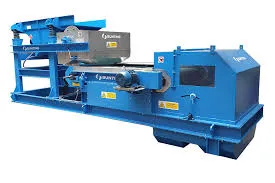
12 月 . 04, 2024 09:41 Back to list
How Does an Eddy Current Separator Work?
Eddy current separators are crucial devices widely used in recycling facilities and manufacturing industries to separate non-ferrous metals from other materials. These machines utilize the principles of electromagnetism to effectively sort materials, making them indispensable in a world increasingly focused on recycling and resource recovery.
At the core of an eddy current separator lies the generation of eddy currents through the interaction of conductive materials and magnetic fields. When an electrically conductive material, such as aluminum or copper, enters the separator, it is exposed to a highly magnetized rotor that spins at high speeds. This rotor is equipped with permanent magnets or electromagnetic coils that create a powerful and fluctuating magnetic field.
How Does an Eddy Current Separator Work?
One unique characteristic of eddy currents is that they generate their own magnetic fields, which oppose the original magnetic field causing them. This phenomenon is a manifestation of Lenz's law, which states that the direction of induced current will always oppose the change in magnetic flux that produced it. As a result, the conductive materials generate an opposing magnetic field that causes them to be repelled away from the rotor.

The separator is designed in such a way that, as the non-ferrous metal materials are ejected by this repulsion, they are directed into a separate collection area. In contrast, non-conductive materials such as plastic, wood, or glass continue to fall through the machine and are collected separately. This capability to effectively separate metals ensures a higher quality of recovered materials, which is crucial for recycling processes.
The efficiency of an eddy current separator largely depends on several factors, including the design of the rotor, the speed of rotation, and the characteristics of the materials being processed. For instance, smaller non-ferrous metals may require adjustments in the magnetic field's strength or the rotor's rotation speed to ensure effective separation. Modern eddy current separators are often equipped with sensors and automated systems to fine-tune these settings in real time, maximizing productivity and minimizing waste.
A significant advantage of using eddy current separators is their ability to operate without the need for manual intervention. This automation not only reduces labor costs but also minimizes the risk of injury associated with manual sorting. Moreover, these separators are environmentally friendly, as they aid in reclaiming metals that would otherwise end up in landfills, promoting sustainable practices in industrial operations.
In conclusion, eddy current separators serve as a sophisticated solution for metal separation in recycling and manufacturing processes. By utilizing the principles of electromagnetism, these devices effectively isolate non-ferrous metals from other materials, enhancing the efficiency of resource recovery. As industries continue to focus on sustainable practices and waste reduction, the importance of technologies like eddy current separators will undoubtedly grow, contributing significantly to the advancement of recycling efforts and the circular economy.
Latest news
Unveiling the Power of Eddy Current Separator
NewsSep.25,2024
Transform Your Home Recyclin:home metal shredder
NewsSep.25,2024
The Future of Waste Management with Recycling Line Picker
NewsSep.25,2024
The Benefits of a Metal Recycling Plant
NewsSep.25,2024
Revolutionize Material Separation with Onwang Technology
NewsSep.25,2024
Innovative Waste Management: Unveiling the MSW Sorting Plant
NewsSep.25,2024